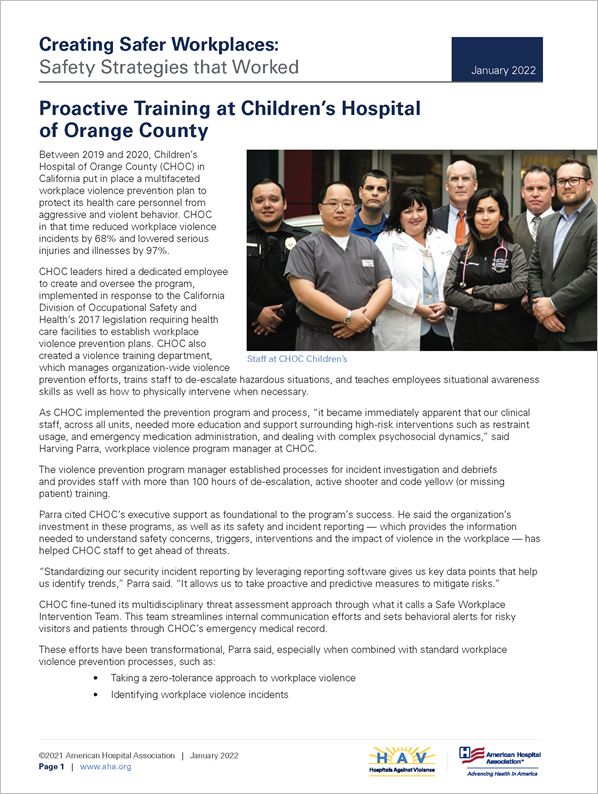Case Study: Proactive Training at Children’s Hospital of Orange County
Between 2019 and 2020, Children’s Hospital of Orange County (CHOC) in California put in place a multifaceted workplace violence prevention plan to protect its health care personnel from aggressive and violent behavior. CHOC in that time reduced workplace violence incidents by 68% and lowered serious injuries and illnesses by 97%.
CHOC leaders hired a dedicated employee to create and oversee the program, implemented in response to the California Division of Occupational Safety and Health’s 2017 legislation requiring health care facilities to establish workplace violence prevention plans. CHOC also created a violence training department, Staff at CHOC Children’s which manages organization-wide violence prevention efforts, trains staff to de-escalate hazardous situations, and teaches employees situational awareness skills as well as how to physically intervene when necessary
As CHOC implemented the prevention program and process, “it became immediately apparent that our clinical staff, across all units, needed more education and support surrounding high-risk interventions such as restraint usage, and emergency medication administration, and dealing with complex psychosocial dynamics,” said Harving Parra, workplace violence program manager at CHOC.
The violence prevention program manager established processes for incident investigation and debriefs and provides staff with more than 100 hours of de-escalation, active shooter and code yellow (or missing patient) training.
Parra cited CHOC’s executive support as foundational to the program’s success. He said the organization’s investment in these programs, as well as its safety and incident reporting — which provides the information needed to understand safety concerns, triggers, interventions and the impact of violence in the workplace — has helped CHOC staff to get ahead of threats.
“Standardizing our security incident reporting by leveraging reporting software gives us key data points that help us identify trends,” Parra said. “It allows us to take proactive and predictive measures to mitigate risks.”
CHOC fine-tuned its multidisciplinary threat assessment approach through what it calls a Safe Workplace Intervention Team. This team streamlines internal communication efforts and sets behavioral alerts for risky visitors and patients through CHOC’s emergency medical record.
These efforts have been transformational, Parra said, especially when combined with standard workplace violence prevention processes, such as:
- Taking a zero-tolerance approach to workplace violence
- Identifying workplace violence incidents
- Standardizing workplace violence investigations
- Conducting annual risk assessments
- Providing staff with incident debriefing resources
- Reviewing annually the workplace violence prevention program
“The change organizationally around workplace violence has been incredible, from an awareness and educational needs standpoint,” said Parra.
CHOC also runs a proactive intervention team called iSTEP, which stands for Implementing Safe TraumaInformed Evidence-based Practices, to address an increase in workplace violence incidents in its medical, neuroscience intensive care and other inpatient units. Team members — including behavioral health, workplace violence, security, customer service and nursing staff — round daily, preemptively identifying potential behavioral issues, microaggressions or incidents of aggressive behavior before they escalate.
Through this early identification, the team can provide necessary resources, recommend consults and take proactive safety measures to guide the staff through difficult situations for better outcomes, Parra said.
This came in handy when a developmentally delayed patient with a documented history of aggressive behavior was admitted for a surgical procedure. The iSTEP team consulted with the patient’s father and learned how to avoid the patient’s triggers and de-escalate any issues before the procedure.
CHOC guided the patient’s nurse through several potential prevention interventions, some of which involved coordinating multiple departments, increasing communication between disciplines and teams, and advocating for the best care possible. Ultimately, the child received exceptional care without incident.
“Although the suggestions required a significant amount of work, they would save the kiddo from being both emotionally and physically traumatized during an intervention should he be triggered and act out aggressively,” Parra said.


